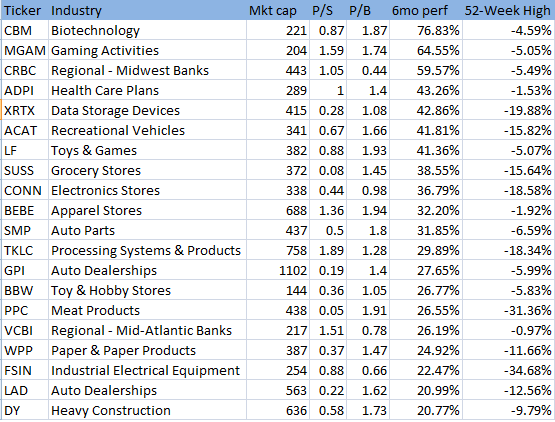The real money in the stock market is made at the two extremes – value and momentum. The unquestionable success of those two approaches has had many capital alchemists pondering if there is something in the middle that could consistently outperform by a wide margin at the expense of lower drawdown. This quest for perfection has given birth to concepts like “Growth at Reasonable Value” and the introduction of P/S to many Momentum approaches.
Earlier this week, Josh Brown wrote a post, featuring James O’Shaughnessy and what he calls the best performing market approach for the past 50 years. This approach combines value and momentum. O’Shaughnessy ranks all stocks based on 4-5 major value criteria (P/S, P/B, P/E…) and creates a cumulative value score for each stock. Then he takes 10% of the stocks with the highest value score and picks the 25 of them with the highest trailing 6 month momentum.
A prudent question here would be, how come this approach has not been arbitraged over time. Usually when a method is insanely successful, it attracts attention and capital, which diminishes its success. If everyone knows that stocks with low P/S outperform, everyone will buy such stocks and as a result this advantage should evaporate over time. This is not the case when momentum is involved. Any market approach that integrates some form of momentum in its ranking, cannot be arbitraged. Relative strength approaches involve buying stocks with the highest performance over certain period of time (for example 3mo, 6mo, 12 mo or a combination of those). The best performing stocks attract the most capital, which makes those stocks even better performing. The whole process continues to feed on itself until the trend is violated due to profit taking.
There is one more important point that I want to make regarding momentum approaches. Relative strength is based on performance, which means that stocks that went up 200% in the past 6mo will be ranked higher than stocks that went up 20%. Such an approach could do a disservice to the market alchemist as a stock that is just breaking out from a multi-year or 6 month range will have very low 6 mo performance and therefore low RS score. Essentially, blindly using RS to rank will lead to missing stocks with high probability of outperforming.

There is no one perfect momentum approach that will let you capture all big winners. A RS approach will help you capture the meatiest part of a trend. You will be able to catch stocks that go up 300% a year, when they are up only 100% (for example, you will notice a stock that is going from $20 to $80 when it is trading at $40). The new high approach will help you spot stocks as they are breaking out to uncharted territory from long bases.
Going back to mixing value and momentum, I ran a quick simplified screen, applying a minimum criteria for P/S<2 and P/B<2 and ranked the resulting universe of stocks based on 6mo RS:

2 thoughts on “Mixing Value and Momentum”
Comments are closed.